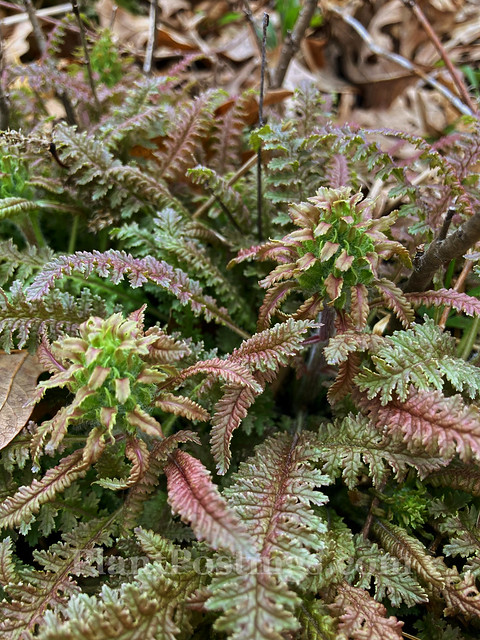
Hiking this time of year is exciting in this part of the world. After the long, cold winter, wildflowers are emerging and the landscape is changing rapidly. On a recent hike, one of the new season plants we noticed was Wood Betony (Pedicularis canadensis). The foliage with its fern-like pattern has a reddish tint in the spring, which changes to green as the plant matures.

I've seen this plant in several parts of Wisconsin, including Door County, Kettle Moraine State Forest, and Lake Kegonsa State Park, not far from my home. It seems to prefer woodland edges and prairies near woodlands. The plant and its yellow flowers are arranged in a spiral rosette with white hairs, making the flower stalk look fuzzy. It's a favorite of bumblebees in the early part of the growing season.
Other common names are Canadian Lousewort and Forest Lousewort, apparently because early colonizers believed that when cattle grazed on the plants they became infested with lice. This plant's native range covers most of the Eastern half of the United States.
If planning to incorporate it in a garden, it prefers full sun to part shade, mesic to dry conditions, and sandy to loamy soil that's somewhat acidic. It grows to 12 inches in height and tends to grow in colonies. It's partially parasitic, so it grows well with other native plants and grasses. Here in my area, it tends to bloom in April-May, but I've seen it still blooming in June further north.


Soon the Wood Betony will be blooming prolifically in one of my favorite wildflower settings. The bees will be very happy, and so will I. Thanks to Gail at Clay and Limestone for hosting Wildflower Wednesday. Head on over to participate!

It's very pretty, Beth. In its yellow form (photo #2) it reminds me a lot of Phlomis fruticosa, which I often refer to as having a Dr Seuss vibe.
ReplyDeleteAh, yes, it does have a similar flower to the Phlomis. I like the "Dr. Seuss" description. :)
DeleteWonderful plant and post.
ReplyDeleteThanks for hosting, Gail!
DeleteLovely plant, Beth in both its foliage and flower form. It has a lush, ferny look about it that I like. -Tina-
ReplyDeleteI've always enjoyed this one, Tina, although I don't have it in my garden. It's fun to find it during hikes in various locations. It's native in your area, too.
DeleteBeautiful!!! We are finally starting to see blooms here. My snowdrops are blooming. YAY!
ReplyDeleteSadly, the bunnies ate my crocus.
Yay! Wow, my Snowdrops are done. Sorry about the Crocuses...the rabbits ate some of mine, too, but they didn't get all of them. Darn rabbits!
DeleteNever heard of it before. Love the foliage.
ReplyDeleteI can think of a handful of places here in Wisconsin where I've seen it really growing in colonies. When the conditions are right, it's a happy, beautiful plant.
DeleteI used to live on the SW shore of Lake Kegonsa many years ago. It’s a beautiful wildflower. I don’t remember seeing it on our walks around the neighborhood. I’m sorry to have missed it!
ReplyDeleteThen you know, Jerry, how beautiful that Lake Kegonsa setting is. The Wood Betony is very happy in a "secret" spot not far from the lake, along a trail. :)
DeleteWhat wonderful plants! I have never seen these beautiful plants. Thank you!
ReplyDeleteYes, they are fun--both the foliage and the flowers. :)
DeleteI have always thought of Wood Betony in an herbal medical sense but never seen it growing. It has a beautiful and unusual bloom.
ReplyDeleteJeannie@GetMeToTheCountry
Ah, that's the thing about common names. I think the herbal Wood Betony often used for health purposes is the European mint Stachys officinalis; while this one is Pedicularis canadensis. Other common names for this one include Common Lousewort or Forest Lousewort. Both are beautiful plants. :)
DeleteThanks for the information. It confirms that you must be extremely careful before using herbs for medicine. Knowledge really matters which is why I enjoy your site. I always learn something new.
DeleteJeannie
Strange but wonderful little plant. I've never seen or heard of it before--lovely it's there when the bumblebees are ready for it.
ReplyDeleteYes, it is a fun little plant. It seems to colonize in locations it likes, and it's nice to know of a few places where we can reliably find it. :)
DeleteWell, I guess i'm in good company that I haven't seen this before either. I love the sticky fuzziness of the flower.
ReplyDeleteYes, it's a special plant and a special bloom. Kind of unique, and it's nice to know of a few locations where we can see it this time of year.
DeleteA beautiful plant I rarely see....thanks for sharing Beth!
ReplyDeleteYou are welcome. I know of a few special places where I can find it. ;-)
Delete